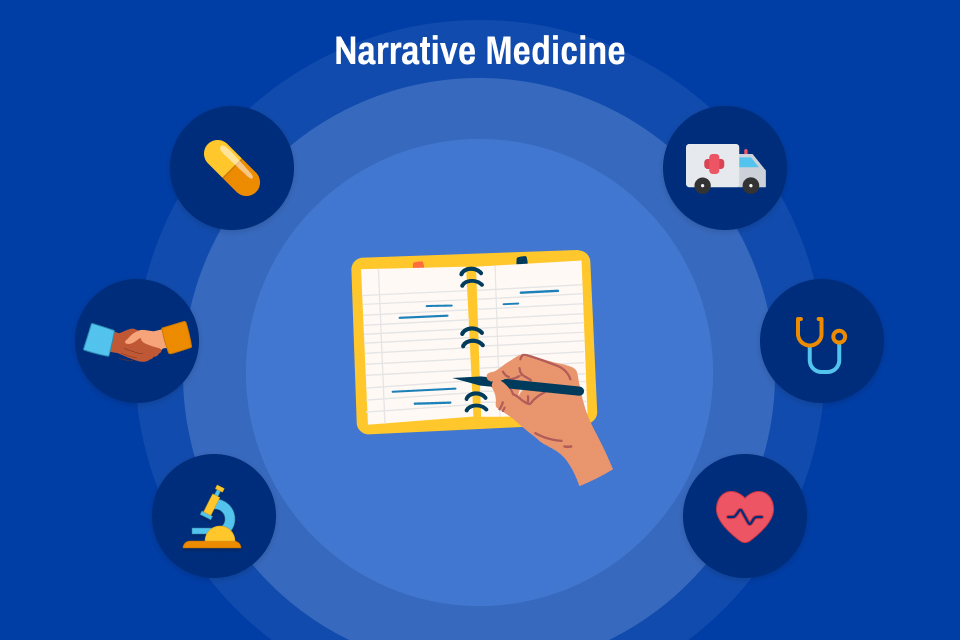The Case for Narrative Medicine
Narrative medicine describes the application of stories within medicine. It can strengthen our listening, writing, and reflecting skills. Narrative medicine has the potential to reinforce many relationships in the clinical space. The first is between the physician and their patients. This is the core of our concentration, where empathy is practiced in real time. Next is the relationship with colleagues.
As providers, we are not alone. We oftentimes experience similar emotions and witness similar experiences separately. Without sharing the realities around us, this can be burdensome. Embracing the opportunity to reflect together can be a form of collaboration. The third relationship is that with society. Since the COVID-19 pandemic, there has been an increase in physician mistrust and skepticism. Sharing what we experience through creative writing, blogs, and news outlets while maintaining patient confidentiality can ease this tension and show the public and our patients how we truly process our experiences.
Engaging in narrative medicine includes listening, acknowledging, interpreting, and acting on the stories of others. At its core, this practice allows us to empathize with our patients and be moved by the stories we hear. Although physicians are knowledgeable about medical illnesses, cultural and social divides may still exist between them and the patient. Regardless of the medical condition, each story individualizes a patient’s experience.
Narrative Medicine in Medical Education
The most memorable patient encounters often do not make it in the chart. I remember visiting my patients’ rooms as a third-year medical student after rounds—chatting, laughing, crying. We bear witness to stories deeper than science. As trainees, we oftentimes experience brief encounters with their patients: We did not know them when they were better and we will not know them when they heal. Trainees are not only new to learning, charting, and presenting in the clinical setting, but are also exposed to the emotional weight of observing vulnerability. How do we, as trainees, make sense of these moments? How can narrative medicine help us process them?
When integrating narrative medicine with medical education, it is important to consider two foundational practices: close reading of literature and reflective writing. Close reading can encourage active with written material, which can improve observational skills and attention. Through this practice, trainees adapt skills to grasp complexity, recognize patient perspectives, and attend to emotional detail. Reflective writing builds upon this, offering a structured space to process, interpret, and integrate clinical experiences. This is not necessarily a summary of events, but rather an expansion of a meaningful encounter. Trainees might write a personal narrative regarding a patient, explore emotional reactions in a journal entry, or craft a creative short story or poem to capture the dimensions of care. Reflective work may take many forms, such as visual art, photography, musical compositions, or performances. Embracing these forms of reflection can help trainees deepen their empathy, enhance clinical insight, and strive towards a more humanistic approach to patient care. Educators can encourage narrative reflection in several ways. One way can be in a single one-hour format. The group spends the first part of the session reading a piece of fiction or nonfiction literature. A facilitator then leads a discussion, oftentimes leading with a writing prompt. In this case, medical students specifically spend time responding to the prompt before sharing at the end of the session. Another design is parallel charting. Parallel charting can create a space for the most important patient encounters that cannot make it into the chart. This begins as a written assignment with a two-column format. The first column includes an objective summary of the patient case. This goes beyond the medical condition: It will include an account of interactions that were held, the patient’s social situation, obstacles and solutions to care. The subsequent “parallel” column will then include a reflection of how the learner perceived the situation. This is space for emotions, personal opinions, and broad applications of what has occurred. If further exploration is desired, this assignment can be a starting point for discussion. A moderator is not required for this. Learners can go around the room and debrief their cases.
These exercises are associated with positive outcomes. Although it does not seem like there is much room for storytelling in surgical fields, it has been utilized through different avenues including morbidity and mortality conferences or case reports. Another study found that learners utilized these peer-led exercises to make connections between their personal beliefs and their patients' circumstances. Finding overlapping features can strengthen relationships and ultimately lead to more compassionate care.
Why does this matter in medical education? Ideally, each day of training should be associated with professional growth for medical students, residents, and fellows. Professional identities are built rapidly in the midst of academic responsibilities and clinical obligations. Embracing narrative medicine can help show trainees how to embrace challenging situations. Patient care reaches beyond clinical knowledge: One must also learn how to react, respond, and process difficult situations. Narrative medicine, however, provides constructive reminders that patients appreciate our advocacy in their care. This helps relieve feelings of burnout in the medical trainee. Curiosity, collaboration, and compassion is enhanced. Indeed, narrative medicine can help trainees cope with the daily challenges of learning clinical medicine.
Conclusion
Training of future clinicians should ideally include space for reflection using narrative medicine. This means providing trainees with protected time for narrative sessions, which may include close reading of texts, shared storytelling, and reflective writing. They can be peer-facilitated or can utilize a moderator. These sessions can provide an opportunity for trainees to have dedicated time to reflect on their experiences. In turn, trainees not only process their encounters, but can become more attentive in the clinical realm. Narrative medicine and reflection within it is a luxury that should be offered to trainees to improve emotional processing and compassionate patient care.
 Dana Alshekhlee is a medical student (Class of 2026) at Saint Louis University School
of Medicine. Dana's areas of professional interest include obstetrics and gynecology,
quality improvement, and medical humanities. Dana can be found on LinkedIn or contacted via email.
Dana Alshekhlee is a medical student (Class of 2026) at Saint Louis University School
of Medicine. Dana's areas of professional interest include obstetrics and gynecology,
quality improvement, and medical humanities. Dana can be found on LinkedIn or contacted via email.
